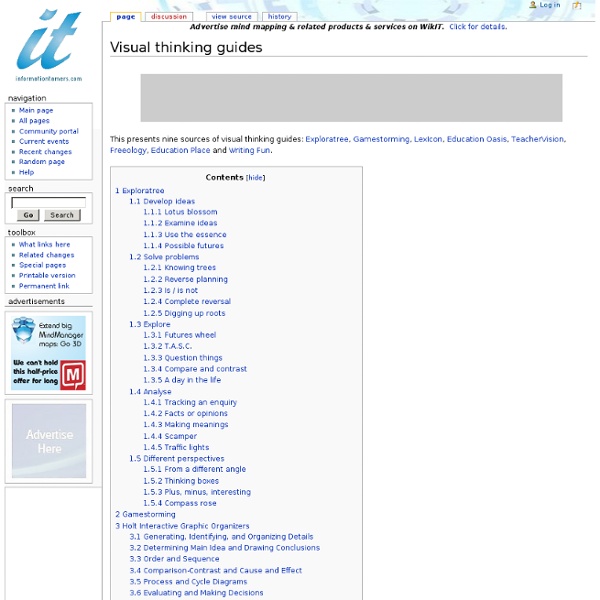Job growth at the best companies to work for
Nicolas Rapp and Anne Vandermey with a straightforward look at new jobs added at the top 100 companies to work for, according to Fortune. Fat paychecks, sweet perks, fun colleagues, and over 70,000 jobs ready to be filled — these employers offer dream workplaces. Like Google, which reclaims the top spot this year to become a three-time champion. Meet this year’s top 100, network with the winners on LinkedIn, and more. Number of new jobs added or lost is on the horizontal, and number of employees at the start of the year on the vertical. There were 7.6 million applicants to Starbucks last year. [Nicolas Rapp]
Getting Started With Mind Mapping Software
This new How-To Guide collects some of the best articles from this blog on how get started with mind mapping software. It provides answers to questions such as why should I use mind mapping in my work? What features should I look for? And where can I get inspired and get a better sense of what types of maps can be created using this type of software? Click on the links below to answers to all those questions and more that will help you to get on your way to being more productive, creative and effective with mind mapping software: How to get started with mind mapping software 5 essential features you should look for when buying mind mapping software The compelling business advantages of mind mapping software (infographic) A mega-map of over 80 of the best mind mapping resources on the web Mind map galleries provide places to help you get inspired The important advantage of mind mapping software you may not know about Related posts Elements of effective mind maps Questions?
Hello
Hello I’m David McCandless, a London-based author, writer and designer. I’ve written for The Guardian, Wired and others. I’m into anything strange and interesting. These days I’m an independent data journalist and information designer. A passion of mine is visualizing information – facts, data, ideas, subjects, issues, statistics, questions – all with the minimum of words. I’m interested in how designed information can help us understand the world, cut through BS and reveal the hidden connections, patterns and stories underneath. My pet-hate is pie charts. Our mission Myself, and the rest of the crack team here at Information is Beautiful, are dedicated to distilling the world’s data, information and knowledge into beautiful, interesting and, above all, useful visualizations, infographics and diagrams. Who funds us? This site is entirely funded by sales of images, posters and books. Stay in touch Want to know more? » I created the Helicopter Game, the most addictive game on the internets.
The Why Axis
Mural.ly
Mindmapping, concept mapping and information organisation software
Articles This is the start of a historical survey of visual mapping. It kicks off with one well-known classic example, and follows up with a very interesting map that has more recently come to my attention. I've written about origins of mind mapping before, but now I'm assembling samples. I've also mentioned elsewhere (see the comments) that I'd like to get samples of Idea Sunbursting that Dr. I preserved it in Freezepage when Google closed down Knol. There's a lot to like in the (unrestrained!)
List of information graphics software
This is a list of software to create any kind of information graphics: either includes the ability to create one or more infographics from a provided data seteither it is provided specifically for information visualization Vector graphics[edit] Vector graphics software can be used for manual graphing or for editing the output of another program. See also[edit] References[edit] Jump up ^ "Homepage".
Mind42.com - Collaborative mind mapping in your browser
5 Brilliant Music Videos Created By Students
Added by Jeff Dunn on 2012-10-28 Bringing classical music to students is not always easy. Except when you incorporate the hottest pop artists into it. Then students and kids around the world will be more than happy to listen. At least that’s the idea behind Collective Cadenza (CDZA), a group that invents “musical video experiments” that mashup today’s hits with the classics of, well, classical music. The group started out at Julliard and turned into quite the mob with more than 55 musicians helping to create some memorable tracks. How To Get Kids Into Classical Music The Human Jukebox 8 Milestones in Recorded Sound The History of Whistling An Abridged History of Western Music in 16 Genres Comments are closed.
How Teachers Actually Feel About Education Technology [Infographic]
How Online Education Has Changed In 10 Years 7.65K Views 0 Likes We all know that education, specifically online education, has come a long way in the last few years. Why TED Talks Have Become So Popular 6.11K Views 0 Likes TED talks are useful and free ways to bring high-level thinking and through-provoking ideas into the classroom and your home. 5 Things To Know About SXSWedu 5.70K Views 0 Likes The real story for anyone reading this is SXSWedu, the education-oriented version of the conference that's turning into a force of nature. How Social Media Is Used Around The World 8.17K Views 0 Likes In a fascinating infographic, we get a look at how social media is used around the world by a variety of countries.



